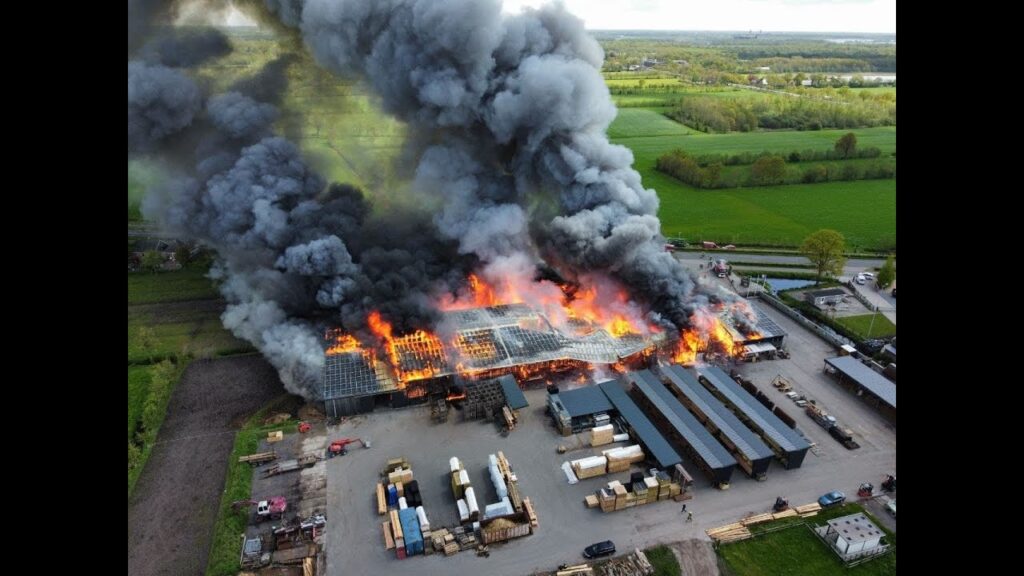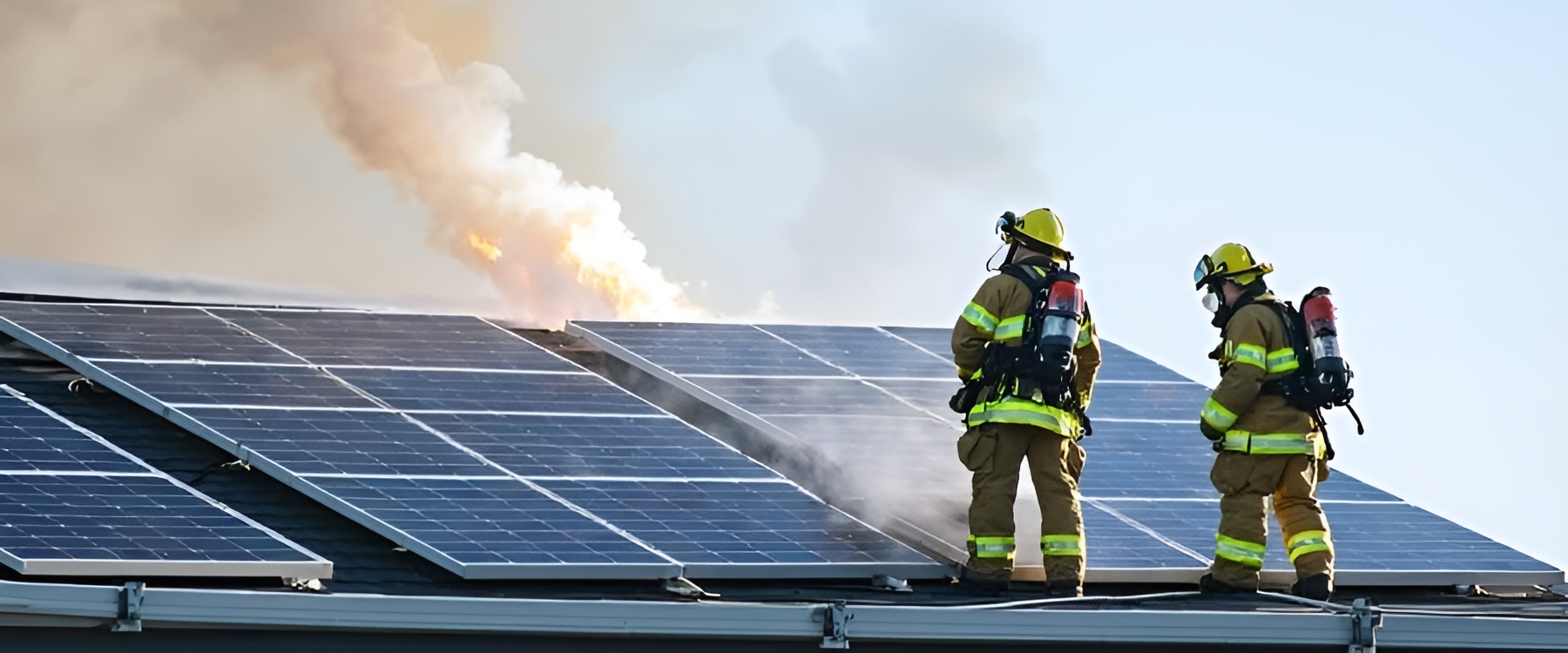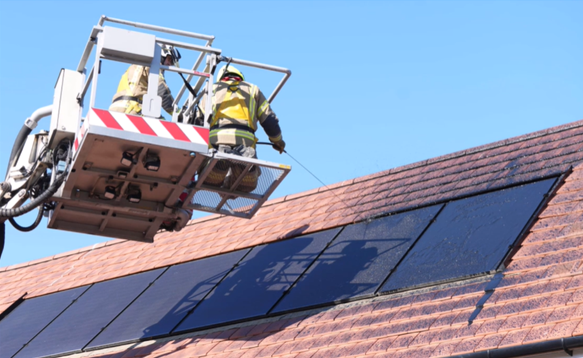
Solar power has emerged as a critical renewable energy source, but commercial-scale solar arrays face a little-known fire risk with potentially major financial and environmental impacts. Innovations like PVSTOP seek to make the solar industry safer by containing and suppressing fires that erupt in solar panel systems. This emerging technology promises huge benefits for insurers and owners of large-scale solar PV Systems.
The solar fire challenge
Most people don’t realize that solar panels can literally catch on fire. However, electrical shorts, damaged wiring and extreme weather can all ignite fires within solar arrays on rooftops or in solar farms. These fires spread rapidly, fuelled by the endless DC electricity flowing from solar cells into conductive wiring running throughout the structural mounts.
The results of a solar fire can be devastating. Hundreds of panels worth over a million dollars can be destroyed in minutes. Toxic smoke and run-off from melted plastics and metals contaminates entire sites. Add to this the loss of clean power generation capacity and the financial toll is massive. Insurers are also starting to recognize the extreme risks that solar system fires pose due to the scale of potential damages for commercial installations.
Yet fighting fires within solar panel arrays poses a unique challenge for firefighters. Electrocution hazards from damaged live wiring can prevent spraying water or foam directly onto burning panels. Fires tucked within racks of panels can hide and evade suppression. And systemic issues trigger panel re-ignition even after apparent extinction.

The PVSTOP solution
PVSTOP provides a simple but highly effective innovation to contain, control and mitigate fires within solar panel installations of any size. The product is an advanced polymer film technology that features proprietary chemistry. When deployed over solar panels, PVSTOP immediately blocks light and de-energises the PV system at the source of power production. The film also dissipates heat while sealing electrical components underneath, preventing re-ignition.
For commercial solar array owners, PVSTOP promises three essential benefits:
- Quick containment of incidents to minimize solar asset loss.
- Reduced clean-up, replacement and environmental remediation costs.
- Prevention of major revenue losses by restoring operation faster.
Insurers also benefit by mitigating massive claim pay-outs to commercial solar power customers in the event of fire-related system damages.
Rapid solar fire suppression
A key capability of PVSTOP is delivering extremely fast solar PV system de-energisation. The lightweight polymer film can encapsulate vast sections of solar panels literally within seconds. This blocks the light, dissipates heat and electrical arcing and prevents wider escalation of an incident. Superior rapid response drastically reduces asset losses compared to traditional firefighting tactics.
PVSTOP’s rapid deployment is the key to limiting damages. The polymer coating can be quickly discharged from portable pressure cylinders stored on-site and sprayed over entire rows of solar panels by technicians in a matter of seconds. Other traditional solutions such as fire extinguishers, or mechanical shut-offs simply cannot deliver the same speed and coverage of PVSTOP extinguishment, and none effectively mitigate the electrical risk at the source of power production. Many of these approaches still leave behind badly damaged panels which pose an ongoing secondary fire hazard until the damaged panels are removed and replaced.
Enhancing PVSTOP with early detection
The ultra-fast fire-suppression capability of PVSTOP can be further enhanced by pairing it with solar panel fire-detection innovations. New sensor systems can identify hotspots and electrical anomalies in solar arrays before visible flames erupt. This early warning allows PVSTOP deployment to start even sooner after an ignition incident begins.
One example is infrared monitoring technology that uses cameras to identify heat build-up indicative of smouldering, before smoking or fire breaks out. Other solutions focus on monitoring DC string voltages to detect anomalies that may signal arcing, shorting or ground faults. Incorporating these early alert abilities with PVSTOP provides the maximum possible jump on containment, drastically reducing damage and replacement needs.
Significant damage to commercial, industrial and utility-scale solar assets could be spared by combining early detection with PVSTOP suppression within 3–5 minutes of the initial failure detection. This would represent an enormous benefit over traditional firefighting that cannot safely access live electrical components buried within panel racks until much later in an event. Early warning detection therefore enhances PVSTOP effectiveness and return on investment for solar system owners.

Maximum solar operation continuity
For owners of commercial-scale solar operations like farms or roof-based arrays, continuity of power generation is essential for profitability. PVSTOP delivers major advantage over alternatives by enabling restored system operation in hours or days – not weeks. The film encapsulation rapidly arrests solar panel electrical risk and destruction, so many panels can be reused once the root cause of ignition is addressed. This prevents immense profit losses from extended solar grid shutdowns.
Additionally, PVSTOP suppresses the propagation of solar fires without causing collateral water or chemical damage throughout the installation. This further maximizes reuse of existing solar infrastructure. Some other fire containment tactics like deluge systems or chemical extinguishers make restoring operation more complex due to contamination or soak-through damage to underlying buildings and equipment. The targeted, clean encapsulation approach of PVSTOP keeps unwanted secondary effects to a minimum.
Lower replacement and remediation costs
Even with fire coverage, many commercial solar panel assets end up being complete write-offs after suffering fire, smoke or chemical damage due to the intricacy of the electrical components and precision structural mounts. But PVSTOP radically reduces complete solar asset losses by arresting the spread of flames before entire sections are engulfed. Salvaging even 30–50% of an affected commercial solar power system saves owners immense expense replacing panels, inverters, racking systems and other supporting infrastructure.
Additionally, containing solar PV incidents with PVSTOP prevents massive environmental clean-up bills down the road. Run-off from water or chemical suppressants can contaminate sites for months, accruing major remediation costs. Melted panel components also create toxic waste. Preventing flames from melting through entire solar panel sections minimizes hazardous by-products that must be disposed of properly. And isolating smoke exposure helps avoid soil disturbances or plant die-offs near solar installations. Overall, the damage control PVSTOP facilitates greatly reduces total costs beyond just panel replacement.
Costs of solar fire pollution
While containment clearly reduces direct solar asset losses, limiting the spread of smoke and run-off from solar fires also prevents massive collateral environmental damages. For example, in 2021 a fire at Europe’s largest solar park in the Netherlands contaminated agricultural lands costing millions of euros.
The blaze filled the air with toxic smoke containing dangerous levels of cadmium and lead from melted solar panels. This smoke plume then rained down particles over thousands of acres of nearby cropland and greenhouses. Testing revealed heavy metal concentrations exceeding safe limits, forcing costly disposal of crops and quarantining of grazing lands.
Estimates indicated remediation expenses over €120 million including disposal of 30,000 tons of contaminated plant material, cleaning of fields, and revenue losses for affected farmers. Meanwhile, in Germany, studies have found solar farm fire run-off has triggered extensive contamination of rivers and groundwater with effects still emerging.
With large-scale solar expanding worldwide, more uncontrolled fires could inflict heavy environmental and economic damages like those observed in the Netherlands and Germany. But solutions like PVSTOP that quickly contain solar fires and toxic emissions offer a pathway to prevent these massive collateral impacts.

Insurer perspectives
Major insurance providers have already acknowledged the immense risk solar panel fires now pose at commercial scales. In 2021, losses from U.S. solar fires exceeded $25 million across more than 85 large claims, catching the industry off guard. Swiss Re and others are rapidly adapting coverage terms in response while premiums are expected to rise sharply. But PVSTOP offers a pathway to control losses with this emerging renewable energy peril.
Insurers stand to benefit tremendously from PVSTOP driving down the costs and occurrence frequency of commercial solar fires. Containing rapid site losses better protects insurance reserves while helping avoid untenable premium increases that could choke the solar industry. And the technology unlocks options for new product offerings like PVSTOP deployment discounts which incentivize proactive solar asset fire safety. Overall, supporting innovations like PVSTOP promises to stabilize renewable energy insurance markets through improved fire-control outcomes.
Conclusion
Solar power delivers immense environmental and economic benefits as an emissions-free energy solution. However, realizing the promise of commercial-scale solar requires controlling largely unknown fire risks that can inflict severe financial and operational damages. PVSTOP represents an exciting advancement that perfectly matches the fire challenge faced by the solar industry today. Rapid encapsulation of burning panel sections promises to revolutionize mitigation capabilities for insurers and owners alike. As PVSTOP adoption spreads, solar power can continue flourishing as an essential sustainable energy source for our future.


